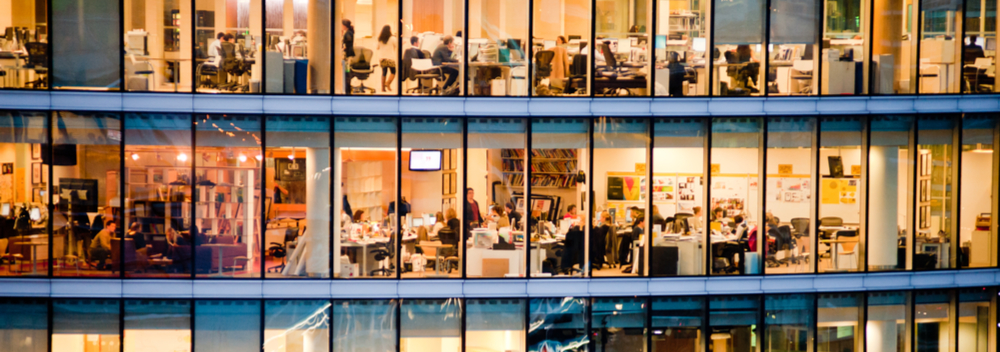Can office design boost productivity?
- 4 Min Read
Everyone wants their employees to be more productive. It’s what will drive better results, more income and, ultimately, healthier profits. However, all too often does the word ‘productivity’ purely conjure up notions of streamlining processes, expunging dead wood and reconfiguring roles and responsibilities. How much impact can your surroundings have, we explore further.
- Author: Emily Sexton-Brown
- Date published: Aug 23, 2018
- Categories

While these things are indisputably important, many employers forget to look around and consider the impact the design of their workspace is having on the productivity of their workforce.
 The fact is that disengaged employees are unproductive employees, so it’s crucial for workers to feel inspired and motivated by the environment they’re working in. The way the workplace is designed plays a huge role in shaping employee behaviour and enabling them to do their job to the best of their ability.
The fact is that disengaged employees are unproductive employees, so it’s crucial for workers to feel inspired and motivated by the environment they’re working in. The way the workplace is designed plays a huge role in shaping employee behaviour and enabling them to do their job to the best of their ability.
While styles of working are in constant evolution and there is increasing emphasis placed on supporting employees’ wellbeing, the workspaces we go today in, day out simply aren’t catering to this – or, at least, not enough of them are. Traditional, old-fashioned, prosaic workspaces are leading to a generation of frustrated workers who are disengaged and unable to thrive in their roles so it’s time more businesses reassessed their space-planning strategies.
If you think the way your workplace is designed might be stifling your business’ potential, here are areas to think about:
- Offer a variety of spaces
Study after study has found that the main issue when it comes to office productivity is that employees feel a lack of control over their daily work experience. One of the most important things workers need is a space that affords them the freedom to dictate how and where they work, according to the task in hand. Being allowed this autonomy encourages workers to feel empowered, engaged and trusted, which naturally fuels productivity. In order to combat stagnant productivity levels, employers should therefore provide a range of spaces that support various modes of work, from creative co-working and agile work to privacy and quiet focus.
- Encourage collaboration
Even the most creative person can’t always form a fully-fledged plan for a project on their own – because doing so relies on just one perspective. Innovation really comes into its own when people are able to exchange and build on ideas in an open, collaborative environment, taking inspiration from others in the group.
With this in mind, it’s important for an office to include open-plan areas that promote teamwork and integration. Spaces where people can share ideas, hold brainstorms and work on projects together – away from their desks and traditional meeting rooms – are surprisingly rare but really do lead to a more productive, engaged workforce.
Design elements such as soft seating, natural light and a mixture of colours, textures and patterns should all be taken into account as these all encourage creative thinking.
- Give staff some privacy
Although open-plan offices undoubtedly have their advantages, it’s not wise to rely on this alone. According to research carried out by Steelcase as part of its Workplace Survey, the average office worker is interrupted every 11 minutes and 25% of lost time is due to distractions in or near a work area. Research also shows that office workers often struggle to manage their need for privacy and find areas where they can simply get their head down. We all have times when we need to buckle down and concentrate on a difficult piece of work without being distracted, and office design should facilitate this.
If your office is open plan, consider installing some cubicle-style focus pods where staff can go to concentrate without interruption. Such work areas can even be acoustically enhanced to minimise noise.
- Use technology to get ahead
If employees don’t have access to the tools they need to work effectively, they can’t be expected to achieve optimum results. Technology continues to dominate the way we work and its influence will only grow as times goes on, so it’s vital to make sure your office is equipped with the requisite kit.
It can be something as simple as making sure there are easily accessible power points where employees will need to plug in laptops and phone chargers, or you might have a business that needs state-of-the-art technology for meeting rooms or screen-sharing technology for training sessions. Think about how your employees’ jobs could be made more efficient, then think about how tech can support this.
- Let staff relax
It’s not all about work. In order to truly perform at our best, we need to be well rested and energised. Too many workplaces are void of a designated social area where staff can go to take some time out and recharge their batteries.
Not only do these spaces – like WorkCafés and breakout areas – enable people to rejuvenate between tasks, but they also help to bolster better relationships between staff and foster a sense of belonging, which in turn improves productivity. Having a separate social space can also help to break down professional hierarchy so staff can communicate ideas more freely and equally which, again, improves processes and output.



